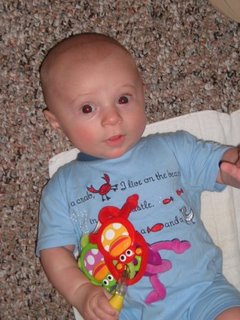Today's Tip - Pay attention to your baby and his preferences to unlock the secret of a full night's sleep
I can deal with only getting about 6 or 7 hours of sleep regularly. But when the baby came along, I was getting that amount of sleep in 2 - 3 hour bursts. After four months, I was ready for my son to sleep hard and sleep long at night. Whether or not you want to try and wean your baby off night feedings is a decision you want to make with your pediatrician. For instance, you might not want to cut out a feeding for an underweight baby at three months. Since my son is an absolute hoss and is almost twenty pounds already, we're giving it a go.
Set him up for successWhile you might need the TV to go to sleep at night, chances are it would do the exact opposite for your infant. Make sure the nursery is a quite room, preferrably away from the street so the neighborhood kids don't wake him up with their screaming. Make it as dim as possible, and keep the room at a comfortable 72 degrees.
RoutineMake a bedtime routine for you and your baby. It can include things like a feeding, a lullaby, story, some relaxing music, baby massage, a bath, etc. Pick your own and stick to them every night. This will tell your baby its time to rest for the night.
Is he tired or are you?Some parents try to put their baby to bed when it's their bedtime, or just because they're tired. Make the bedtime routine about your baby's schedule. Most babies, after being up all day, are ready for bed in between 8 and 10 pm. Set aside time in your schedule for the routine, and it doesn't hurt to sleep when the baby does. Or, if you need the time to do other things, plan your free time after he goes to bed. Don't plan your baby's bedtime based on what you need to do that night.
Be SoothingRemember, if you're stressed out, the baby is probably stressed out. To help him sleep through the night, try to be as patient as possible. Some babies take to it better than others. Some wake easily and it takes them awhile to sleep through the night. If he does wake up, be as soothing as possible. Keep the lights low, don't make any loud sounds. Act like you would during your baby's bedtime routine, no matter how much he wants to play.
Crying it OutThere's plenty of debate on this. If your baby cries every time you set him down to go to bed, try letting him go for a few minutes. Come back, pat him and reassure him, but don't pick him up. Then leave again. Repeat as needed. This might not work for all babies...some just work themselves into a rage. My son has no problem crying for a half hour or so if he's not happy, and he's not falling asleep after it. If you know he's fed and diapered and not hurt, you might want to try the crying it out strategy to see if it works.
Lay Down AwakeAlways put your son down to sleep awake. When they wake up in the middle of the night, they won't need a bottle or a cuddle to fall asleep - they'll know that they can fall asleep on their own, in their crib. So if he nods off during the last feeding or in your arms on the way up to bed, try to wake him up just a little as you set him down.
It also could be...It might not be that your baby doesn't know how to sleep through the night. There could be something else going on. He could be teething, hungry, had too many naps during the day, had too little naps during the day, too warm or cold, have colic or an ear infection. You know your child best, and if something seems amiss, don't just chalk it up as normal. Do a double check of other possible causes.
Parenting,
Sleep,
Through,
Night,
Routine














